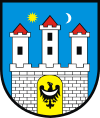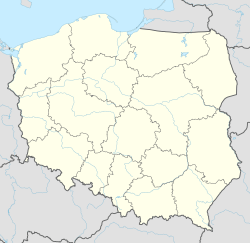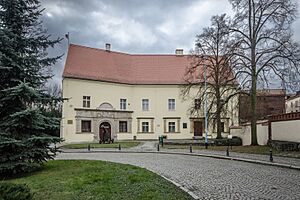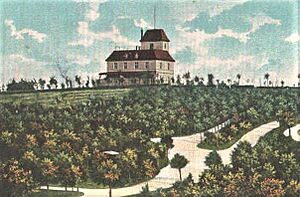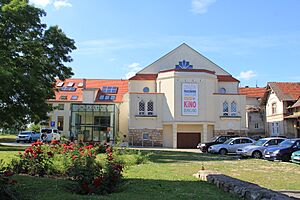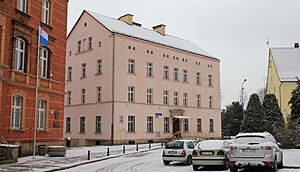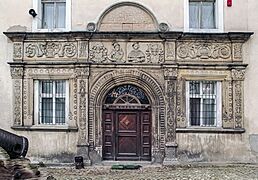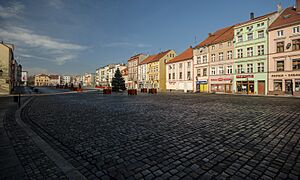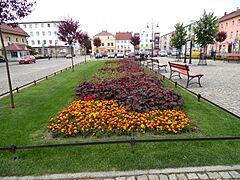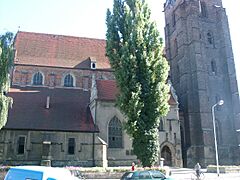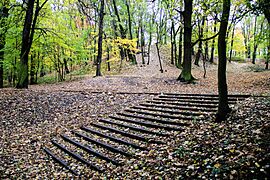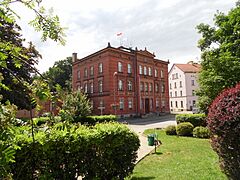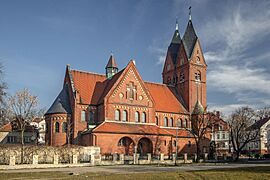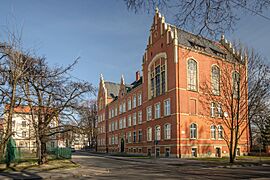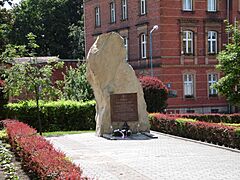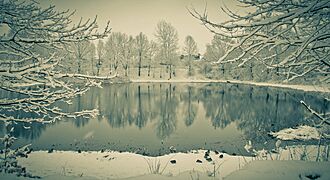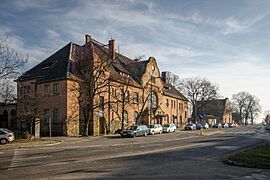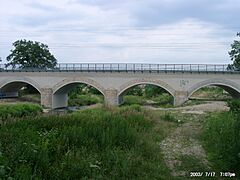Chojnów facts for kids
Quick facts for kids
Chojnów
|
|||
|---|---|---|---|
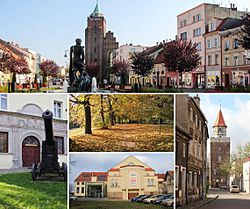
Market Square, Castle, Park, Cultural center, Weavers Tower
|
|||
|
|||
| Country | |||
| Voivodeship | |||
| County | Legnica | ||
| Gmina | Chojnów (urban gmina) | ||
| Established | 14th century | ||
| Town rights | 1333 | ||
| Area | |||
| • Total | 5.32 km2 (2.05 sq mi) | ||
| Elevation | 170 m (560 ft) | ||
| Population
(31 December 2021)
|
|||
| • Total | 13,002 | ||
| • Density | 2,444.0/km2 (6,330/sq mi) | ||
| Time zone | UTC+1 (CET) | ||
| • Summer (DST) | UTC+2 (CEST) | ||
| Postal code |
59-224, 59-225
|
||
| Area code(s) | +48 76 | ||
| Car plates | DLE | ||
Chojnów is a small town in south-western Poland. It is located in the Lower Silesian Voivodeship, near the city of Legnica. The town sits on the Skora river, which flows into the Kaczawa river. Chojnów is about 170 meters (558 feet) above sea level.
As of December 2021, Chojnów has about 13,000 people living there. It is the main town for the surrounding rural area, but it is a separate town on its own. Chojnów is well-connected by roads and railways to other cities. It is also close to the A4 motorway.
Contents
- What is the Chojnów Coat of Arms?
- Where is Chojnów Located?
- A Brief History of Chojnów
- Population Growth
- What Does Chojnów Produce?
- Places to See and Nature in Chojnów
- Culture and Sports in Chojnów
- Education in Chojnów
- Religion in Chojnów
- Famous People from Chojnów
- Chojnów's Sister Cities
- Gallery
- See also
What is the Chojnów Coat of Arms?
The Chojnów coat of arms is a blue shield. It shows a white castle with three towers. A silver crescent moon is on the right side of the middle tower. A golden sun is on the left side. Inside the castle gate, there is a Silesian Eagle on a yellow background. Chojnów's motto is "Friendly City."
Where is Chojnów Located?
Chojnów is in the central-western part of the Lower Silesia region. The Skora River flows through the town towards the west. The town covers an area of 5.32 square kilometers (2.05 square miles). About 41% of this land is used for farming.
The town has good connections to major cities by road and rail. The A4 motorway is just 5 kilometers (3 miles) south of Chojnów. To the south of the town, you can find the Chojnowska Plain.
A Brief History of Chojnów
Chojnów was first mentioned in a Latin document in 1253. At that time, it was called Honowo. The name "Chojnów" comes from Polish. Later, the German name "Haynau" was used.
The town was officially called a "civitas" (a type of city) in 1288. It received its town rights in 1333 from Duke Bolesław III the Generous. Chojnów was part of different duchies in Poland. It remained under the rule of the Piast dynasty until 1675. Most of its people were Polish.
In the 14th and early 15th centuries, Chojnów grew a lot. It received special rights, like the right to control trade and mine for gold. This helped the town become very successful.
Challenges and Changes Over Time
The town faced many challenges. The Hussites, a religious group, burned most of the town center and castle. But Chojnów quickly rebuilt itself. The 16th century was a great time for the town. However, by the end of that century, fires and diseases caused its decline. A serious disease outbreak in 1613 affected many people.
During the Thirty Years' War (1618–1648), Chojnów suffered again. It was taken over by Austrian and Swedish armies. In 1642, the Swedes also took many things from the town. Chojnów was part of the Duchy of Legnica until 1675. Then, it became part of Bohemia, ruled by the House of Habsburg.
In the 1700s, cloth production became important in Chojnów. A school for making cloth was even started. Important routes connecting Warsaw and Dresden passed through the town. Polish Kings Augustus II the Strong and Augustus III of Poland traveled through Chojnów many times. In 1740, Prussia took control of the town.
During the Napoleonic wars, more diseases spread. In 1813, Napoleon Bonaparte himself gave orders in Chojnów. This event is remembered with a special plaque on the Piast Castle. In the 1800s, a railway line was built. The town also got sewers, gas lighting, a newspaper, and a hospital. This helped the town's economy improve.
Chojnów in Modern Times
Chojnów was damaged during World War II. About 30% of the town was destroyed in 1945. After the war, in 1945, the town became part of Poland. Many Poles moved to Chojnów to live there. These Poles had to leave their homes in eastern Poland. In 1946, the town was officially renamed Chojnów. Some Greek refugees also settled in Chojnów after their civil war.
Population Growth
- 1428 – 15 inhabitants
- 1633 – 500
- 1657 – 180
- 1742 – 400
- 1788 – 20,176
- 1801 – 2,314
- 1890 – 8,115
- 1910 – 10,500
- 2005 – 14,510
- 2011 – 14,367
What Does Chojnów Produce?
Chojnów is a town with both industries and farms. Local factories make many different products. These include paper, farm machines, chains, and metal hospital furniture. They also produce equipment for the meat industry. Other products are beer, wine, leather clothes, and clothes for babies, children, and adults.
Places to See and Nature in Chojnów
Chojnów has several interesting historical sites. You can visit the 13th-century castle of the Dukes of Legnica. This castle is now a museum. There are also two old churches and the Baszta Tkaczy (Weavers' Tower). You can still see parts of the old city walls.
The largest green space in Chojnów is Park Piastowski (Piast's Park). It is named after the Piast dynasty. In the Chojnów area, you might see wild animals. These include roe deer, foxes, and rabbits.
Culture and Sports in Chojnów
Every year in early June, Chojnów celebrates its "Days of Chojnów." A bike race called "Masters" is also held yearly in the town.
Chojnów has a Municipal sports and recreation center. It was created in 2008. This center hosts many events, festivals, and competitions. The regional Museum is located in the old Piast castle. It has collections of old tiles and other historical items. Next to the Museum, there is a public library. In the central park, near the Town Hall, you can find an amphitheatre.
The local government publishes a weekly newspaper called Gazeta Chojnowska. It has been published since 1992. It is one of the oldest newspapers in Poland that has been published without stopping. Another official newspaper for Chojnów is called "Chojnów."
Education in Chojnów
Chojnów has two kindergartens, two elementary schools, and two middle schools.
- Mary Konopnickiej is the smallest elementary school. It is in the northern part of the city, near the train station. It was founded in 1962.
- Janusz Korczak is the largest primary school. It is in the southern part of the town.
- Middle School No. (Pope John Paul II) is in the north-western part of the city. It is next to the "Small Church."
- Gimnazjum nr 2 im. Nicolaus Copernicus is the largest high school in Chojnów.
- Liceum Ogólnokształcące im. Nicolaus Copernicus is another high school.
Religion in Chojnów
Chojnów is part of the Catholic deanery of Chojnów. It has two Catholic parishes: Immaculate Conception of the Blessed Virgin Mary and Holy Apostles Peter and Paul. Both churches have active groups of people who attend services. There are also two groups of Jehovah's Witnesses in the town.
Famous People from Chojnów
- Johann Wilhelm Ritter (1776–1810), a chemist and physicist
- Georg Michaelis (1857–1936), a politician who was Chancellor of Germany
- Edith Jacobson (1897–1978), a German psychoanalyst
- Oswald Lange (1912–2000), a German–American aerospace engineer
- Horst Mahler (born 1936), a German lawyer and activist
Chojnów's Sister Cities
Chojnów has special friendships with other towns around the world. These are called "sister cities."
 Commentry, France
Commentry, France Egelsbach, Germany
Egelsbach, Germany Mnichovo Hradiště, Czech Republic
Mnichovo Hradiště, Czech Republic
Gallery
-
Monument to Polish soldiers killed in World War II and exiled to Siberia
See also
 In Spanish: Chojnów para niños
In Spanish: Chojnów para niños



